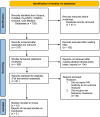HIV among people who inject drugs in India: a systematic review
- PMID: 35948967
- PMCID: PMC9367073
- DOI: 10.1186/s12889-022-13922-2
HIV among people who inject drugs in India: a systematic review
Abstract
Background: Little is known about the epidemiology of HIV infection among HIV positive people who inject drugs (PWID) in India. Injecting drug use has emerged as an important route of HIV transmission in India. The objective of this study was to conduct a systematic review on the risk behaviours associated with HIV infection among HIV positive PWID and assess the data reported.
Methods: A systematic search of six electronic databases, Scopus, PubMed, PsycINFO, CINAHL, Embase and Ovid Medline was conducted. These databases were searched for published studies on injecting risk behaviours, sexual risk behaviours and socio-demographic factors associated with HIV infection among HIV positive PWID in India.
Results: A total of 15 studies were included in the review of which 3 studies evaluated HIV/HCV coinfection among HIV positive PWID. Older age, low educational level and employment status were significantly associated with HIV infection. Sharing of syringe and needle, frequency of injection, early initiation of injecting practice, inconsistent condom use and having multiple sexual partners were all commonly associated with HIV infection among HIV positive PWID.
Conclusion: Our study identified significant injecting and sexual risk behaviours among HIV positive PWID in India. There is an increasing HIV transmission among PWID in different states, more so in the northeastern states and in metropolitan cities in India. More studies need to be conducted in other regions of the country to understand the true burden of the disease. The lack of sufficient data among HIV positive female PWID does not preclude the possibility of a hidden epidemic among female PWID. The need of the hour is for the prevention of further transmission by this high-risk group through the provision of comprehensive programs, surveillance and robust continuation of harm reduction services.
Keywords: Co-infection; Human immuno-deficiency virus; India; People who inject drugs.
© 2022. The Author(s).
Conflict of interest statement
The authors declare that they have no competing interests.
Figures
Similar articles
-
Young people who inject drugs in India have high HIV incidence and behavioural risk: a cross-sectional study.J Int AIDS Soc. 2019 May;22(5):e25287. doi: 10.1002/jia2.25287. J Int AIDS Soc. 2019. PMID: 31116005 Free PMC article.
-
HIV and its associated factors among people who inject drugs in Mizoram, Northeast India.PLoS One. 2023 May 22;18(5):e0286009. doi: 10.1371/journal.pone.0286009. eCollection 2023. PLoS One. 2023. PMID: 37216389 Free PMC article.
-
Injection network drivers of HIV prevention service utilization among people who inject drugs: results of a community-based sociometric network cohort in New Delhi, India.J Int AIDS Soc. 2024 Apr;27(4):e26241. doi: 10.1002/jia2.26241. J Int AIDS Soc. 2024. PMID: 38632848 Free PMC article.
-
Injecting risk behaviours amongst people who inject drugs: A global multi-stage systematic review and meta-analysis.Int J Drug Policy. 2020 Oct;84:102866. doi: 10.1016/j.drugpo.2020.102866. Epub 2020 Jul 24. Int J Drug Policy. 2020. PMID: 32712484
-
HIV prevalence among people who inject drugs (PWID) and related factors in Iran: a systematic review, meta-analysis and trend analysis.Addiction. 2020 Apr;115(4):605-622. doi: 10.1111/add.14853. Epub 2020 Jan 11. Addiction. 2020. PMID: 31631425
Cited by
-
HIV, hepatitis B & C in people who inject drugs in India: A systematic review of regional heterogeneity & overview of opioid substitution treatment.Indian J Med Res. 2023 Nov 1;158(5&6):522-534. doi: 10.4103/ijmr.ijmr_1930_23. Epub 2024 Jan 24. Indian J Med Res. 2023. PMID: 38265946 Free PMC article.
-
Risk Factors Among HIV Seropositive Cases Attending a Tertiary Care Hospital of a North-Eastern State of India: A Hospital-Based Retrospective Cross-Sectional Study.Cureus. 2025 Mar 12;17(3):e80455. doi: 10.7759/cureus.80455. eCollection 2025 Mar. Cureus. 2025. PMID: 40225524 Free PMC article.
-
The use of oral HIV pre-exposure prophylaxis among people who inject drugs: barriers, and recommendations.Front Public Health. 2023 Sep 5;11:1265063. doi: 10.3389/fpubh.2023.1265063. eCollection 2023. Front Public Health. 2023. PMID: 37732092 Free PMC article. No abstract available.
-
Understanding the epidemiology of substance use in India: A review of nationwide surveys.Indian J Psychiatry. 2023 May;65(5):498-505. doi: 10.4103/indianjpsychiatry.indianjpsychiatry_791_22. Epub 2023 May 15. Indian J Psychiatry. 2023. PMID: 37397843 Free PMC article. Review.
-
Respondent-driven sampling is more efficient than facility-based strategies at identifying undiagnosed people who inject drugs living with HIV in India.Drug Alcohol Depend. 2023 Aug 1;249:110834. doi: 10.1016/j.drugalcdep.2023.110834. Epub 2023 Jun 16. Drug Alcohol Depend. 2023. PMID: 37352733 Free PMC article.
References
-
- United Nations Office on Drugs and Crime. World Drug Report 2020 2020 [accessed on 16 December 2020]. Available from: https://wdr.unodc.org/wdr2020/field/WDR20_Booklet_2.pdf.
-
- World Health Organization. HIV/AIDS 30 November 2020 [accessed on 3 December 2020]. Available from: https://www.who.int/news-room/fact-sheets/detail/hiv-aids.
-
- Panda S. HIV in IDUs: Should we bother? Int J Drug Policy. 2003;14(1):83–85. doi: 10.1016/S0955-3959(02)00212-8.PubMedPMID:2003-02937-009. - DOI
-
- Department of Health and Family Welfare MoHaFW, Government of India. Annual Report 2019–2020 2020. Available from: https://main.mohfw.gov.in/sites/default/files/Annual%20Report%202019-202....
Publication types
MeSH terms
LinkOut - more resources
Full Text Sources
Medical


